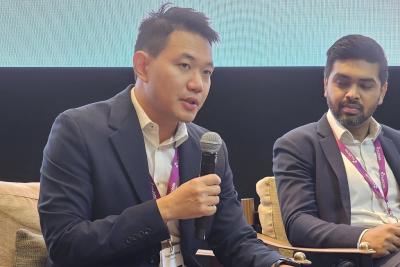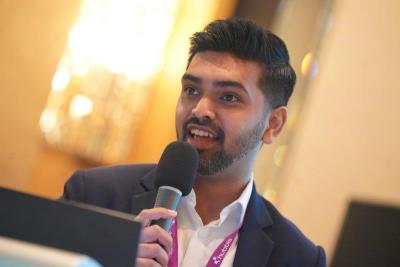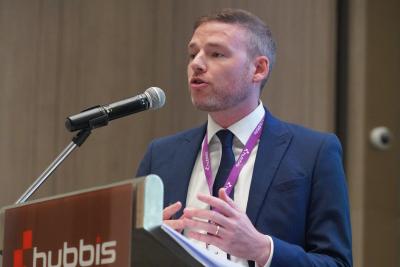Thai Wealth Management Industry Looks Overseas to Boost Investment Offerings

Sep 20, 2018
The growing demand for foreign investments from wealthy clients and institutional investors in Thailand is bringing many opportunities and also challenges for banks, securities houses, asset managers and insurance companies. Hubbis and Leonteq organised a high-level gathering of experts at a private, off-the-record discussion to analyse the state of the industry and plot the paths towards an even more exciting future.
Foreign investment fund (FIF) assets in Thailand grew 15% annually to THB1.17trn (USD35.5bn) in 2017, according to Bank of Thailand’s 2017 financial stability report. FIF assets now account for almost 26% of Thailand’s THB4.54trn (USD138 billion) mutual fund industry, which grew 7% during the full year 2017, according to the central bank’s report.
In September 2017, the Bank of Thailand further relaxed rules on offshore investment and fund managers have seen rising demand from Thai investors for overseas exposure, launching more and more FIFs last year, which totaled 590 by the end of 2017, up almost 26% from 469 in 2016.
Fixed income funds remain more popular than equity funds in Thailand, according to data from the Securities and Exchange Commission (SEC). Fixed income funds accounted for 60% of the industry, with equity funds around 22%. And there is increasing diversification in the remaining 18% of assets.
Views from the top
An eclectic group of top-tier representatives from leading Thai, regional and global banks, securities companies, asset managers and insurers met to exchange ideas. The fifteen leading professionals included Presidents, CEOs, first vice presidents, heads of private banking, heads of investment advisory, heads of wealth management, and heads of foreign investment.
The discussion was formulated to discuss how these firms can capitalise on the growing demand for foreign investments, how they build capacity and capability, what mainstream and new investment products they are focusing on, how the end-investor can be educated, what the regulatory environment offers today and how Thai institutions are building their digital platforms to enable more investment flows.
Setting the scene
The discussion began with several of the senior level Thai bankers and asset managers giving their insights into the world of Thai wealth management. “Thai investors over the past 10 to 15 years have become increasingly outward looking,” said a leading banker. “The FIF market has expanded at a rate of more than 17 per cent a year in the past decade. But having said that, we are still highly biased to the home market and to fixed income.”
He also explained that structured notes have been an area of focus in more recent years. “There is also increasing interest in, and appetite for, leveraged or multi-asset products, so we see increasing product sophistication coming in. On the whole, we prefer simplicity and ease of understanding for our clients, we do not like complexity. But we can indeed promote things like structured products where there is a good reason for buying into them.”
A banker who had worked in the Thai financial services market for more than three decades commented how much more knowledgeable the Thai investor is today, and also increasingly receptive to investment ideas to make their money work for them.
Another banker noted that especially for high net worth individuals (HNWIs) with investible funds of more than USD3 million there is also greater interest in offshore investments that are sourced and executed offshore. He added that those HNWIs with lower amounts to invest are generally fine to stick to Thai sourced assets, including those foreign assets offered onshore in Thailand. “Thai investors are generally ever more receptive to ideas, but they need to be wary of the foreign exchange risk inherent in international assets.”
The Thai market has traditionally seen foreign asset management companies collaborating with local asset management companies to promote feeder funds to access foreign assets. “Will the market continue that way?” asked an attendee. “We are looking at a whole variety of solutions, including direct access offshore,” replied a representative from a leading asset management firm.
Another expert noted that some of Thailand’s HNWI offshore money is flowing back to Thailand because investors lost out by being away from the Thai baht, which has remained relatively strong against most currencies. “We believe FIF is here to say because it is transparent and established,” he observed. “And the regulators are more accommodative in approving funds, including more complex products, therefore further enabling both acceleration and diversification.”
Investor behavior
Segmentation was raised as a strategy by another expert. “We plan to follow the lead of other big banks and begin to segment clients in groupings according to their investible funds. And we need to define how we service each segment. Another area we are moving towards is open architecture, perhaps not fully open, but available for some of these categories, for example.
A senior representative of a foreign insurance company noted that demand for insurance solutions in the HNWI segment in Thailand is also growing apace. “We partner with a major Thai financial group to access and service this fast-growth segment,” he reported. “Their options remain fairly limited, so our concept is of course to diversify their portfolios. Many of these clients like to park their wealth globally, not only in Thailand, especially as Thailand itself becomes more global. Each client and each family has its own needs and interests, so this is a fascinating segment to focus on. Our unit-linked product has performed well, it is designed to cater to HNWIs and affluent Thais, who are generally increasingly receptive to life insurance and similar solutions, something they have been reluctant to discuss easily in the past.”
Insurance solutions become more mainstream
The same expert noted how his group also owns a private bank in Europe. "We always advise our European clients to have a portion of their assets in insurance products, for example, principal-protected solutions. The clients here need to consider insurance as another asset class; they can take a risk in a portion of their assets, but they need to protect a large portion of their wealth for current and future generations. Insurance becomes part of the estate management and transition planning focus. We hope that in Thailand insurance will become increasingly tax-advantaged, as it often is in Europe."
Another global insurance company representative, who looks after the firm’s relationship with a major Thai bank group, reported that his mission was to look after the partnership’s assurance strategy, especially unit-linked insurance. “Unit-linked has been here for the past eight or more years,” he said, “but in the past 18 months or so it has really started to take off, partly due to the great work of the partnership we just heard from, which has been doing a great job here.”
He noted that the single premium facet of unit-linked in Thailand is very advantageous, not only for the customer but also for the underwriters and the distributors. “It has some considerable advantages over a general unit trust or mutual fund,” he elucidated, “particularly when we start to blend wealth accumulation with wealth protection. The regulatory framework does need some work and I think the market is overly leaning towards agency distribution, whereas we do not want to sell products so much as sell solutions to customers’ future dreams, aspirations and ambitions. In general, therefore, I think there is considerable upside from many aspects.”
Diversifying the insurance offerings
The same expert explained that the bancassurance industry in Thailand has been fed on a diet of relatively safe, secure IRR-type products. “But we aim to promote more education planning, retirement planning, greater diversification and choice. We need HNWI clients to think about insurance as providing another asset they can leave to their next of kin, especially where companies or property are involved. Unit-linked is obviously another medium for doing that. In short, we see exciting times ahead.”
Jeremy Ng, Leonteq CEO in Asia, then spoke, to highlight some of the structured solutions the firm offers in Thailand.
He began with a brief background on Leonteq, which he noted was founded in Switzerland 11 years ago by some experts who had left the products trading team at Goldman Sachs. “Fast forward to today,” Ng reported, “and we are now operating in 11 countries and serve over 30 markets across Europe and Asia. Here in Thailand, as the appetite for foreign investment products develops, we intend to become a privilege partner to local financial institutions.
He explained that Leonteq’s mission is to first understand the Thai market from the perspectives of the industry experts and end clients. “We need to understand appetite, objectives, market segmentation and so forth, in order to provide products that are relevant and appealing to this market,” he explained.
Ng then highlighted how Leonteq works in other markets in the region, noting that the firm works closely with private banks, securities houses and asset managers. “We tailor products to investor perception and sentiment, as well as to market realities,” he explained. “The products in recent years have reflected bullish investor sentiment, and now with more volatile market conditions, there is a shift of appetite from leveraged participation products to more enhancement structures and even to a large extent, going into principal guarantee structures, which have become much more popular. We are also structuring products that offer some kind of hedging in uncertain market conditions. From a portfolio construction standpoint, there is a certain element of insurance involved.”
Evolving the wealth management industry
The discussion turned to the evolution of the wealth management proposition in Thailand. An attendee asked if, in the Thai market, where fees are made selling funds, bonds, equities, structured products and so forth, advisory income might become more prevalent, as has been the case in the shift within wealth management in Switzerland.
A senior banker from a universal Thai bank replied that his bank likes to consider that they are selling solutions more than products. “We like to approach this from the perspective of financial planning for our clients,” he said. “We, therefore, sell the total package, the bigger solution. But we are not asking for advisory fees, as the product is the underlying asset that goes into the portfolio, and we earn our fees on those products. If it is a discretionary or private fund, we are not charging the client extra fees, largely because the Thai investor does not like to pay fees for things that appear intangible, so what is effectively an advisory fee comes through the product fees. They would not want to pay for what might be called advice when we already provide that advice as part of the overall planning and portfolio discussions.”
Nevertheless, he conceded that front-end fees will gradually become more difficult, and Thailand will eventually follow the European type model. “A management fee model is somewhere there in the future,” he said, “but not yet.”
A leading Thai finance expert whose firm has entered into a relationship with a leading Swiss private bank reported that for expansion of product into the rising demand for foreign assets the partnership is working very well, especially for ultra-HNWI clients where the mission is essentially to look after a family’s money on a longer-term view.
“The Swiss bank we partner with is a bespoke name and it resonates with our big family clients, some of whom are extremely wealthy. We are already past USD1 billion in asset under management and we have worked together to train up 20 specialist staff, including sending them to Switzerland for training. We actually designed the training programme ourselves, something the Swiss bank has been very impressed with. The quality of our relationship managers is essential to our business model, which is why we are investing time and resources there. The partnership works as a powerful two-way flow and we are both clear on what we want.”
He also explained that both partners are clear on what they do not want. “No churning of the portfolios. No product pushing for the sake of it. Our partner has more than two hundred years of history, they are looking for the long-term relationship building and that suits our business model very well. We sell controlled risk - we tell our customers that we can generate higher returns, but with those comes higher risk. We are seeking to help the clients build and preserve money for the next generations.”
Another senior banker reported that his approach was portfolio construction for HNWIs. “We look at the whole picture of portfolio building including significant overseas assets, especially for those with USD3 million or more to invest. This would include bonds, equities, funds and potentially structured products as well.”
Regulation – Thai authorities show flexibility
The discussion turned to regulation, on which there was general agreement that for non-insurance products the Thai regulators are liberalising appropriately and they also recognise that there are different categories, in other words, more sophisticated wealth investors and less sophisticated mass market or mass affluent investors.
But on the insurance front, one expert noted that the regulators treat everyone the same. “It is the ‘everyone needs to be protected’ approach,” he explained. “No foreign currency product, no foreign company to solicit, which means the competitive situation is weak. So HNWIs buy the more sophisticated products offshore. The regulator needs to take a leaf from the Bank of Thailand and SEC books and differentiate between insurance customers, so more product can be sold to them onshore.”
This same expert noted that the offshore purchasing is worth at least THB10 billion and represents HNWIs seeking to keep funds offshore as a hedge against Thailand’s political or economic situation, as well as seeking to match liabilities they might have offshore. “Additionally, there is the currency aspect as dollar assets product higher returns than Thai baht. With leverage, they can achieve a higher return than the premium costs.”
Another insurance expert noted that there is some negative regulation coming through to limit the ability of a relationship manager or marketing officer from the bank to operate outside the branch. “The objective seems to be to protect the agency insurance distribution network," he said. "We do not like this as it seems anti-competition and antithetical to freedom of choice for the customers. We understand that there is pressure from different associations it is somewhat of a retrograde step. But we are making representations to ask the regulator to be more flexible. Our view is simply that competition creates a better service and better advice.”
Views on what the regulators can do in general to improve things included FIF approvals in a week rather than 60 days. Another perspective was for regulators to more overtly consider the cost to banks, insurers and asset managers of their regulations and the ensuing compliance.
Xavier Burkhardt, executive director at Leonteq and responsible for Thai market added his insight on regulation. “We see the Thai regulators as quite progressive and willing to support the development of the onshore wealth management market”
How Loenteq can add to the diversification trend
Burkhardt also noted that Leonteq is working more closely with local financial institutions, educating them on structured products and contributing to expand their range of investment opportunities.
Burkhardt talked about popular structured products in Singapore and Hong Kong currently. He also mentioned that structured solutions can help intermediaries to promote smarter products with a better risk return profile for their end clients, while generating additional source of sales revenues
Burkhardt was also keen to stress how the structured product market in the past decade market had become far more transparent; liquid and competitive. “We manufacture bespoke products at a low cost with daily liquidity and detailed performance information available online. Buying a structured product has become much more mainstream and easy to access for accredited and institutional investors. Being a pure and independent player dedicated to structure investment solutions help us to stay a leading provider, keep our edge and offer the best client services.
Burkhardt then highlighted some noteworthy popular products in Asia. “The fixed coupon note, or FCN, is a yield enhancement product where you combine some yield on the upside and some protection on the downside. And participation products are also popular. The question really for the end-customers is do they want yield, participation, or protection? If they want protection, it is usually a longer product of two years to five years. And if you want more yield or more participation it is generally a shorter-term product.”
He explained a typical participation product. “To make it simple, let’s say you are bullish on the Thai index and you are bullish on the US market, but you do not know which one would perform better in the next 12 months. We combine them both in one product and we are able to give the investor, for example, twice to the upside index participation with only 50% of the downside. Alternatively; the investor will get 100% of the upside will not lose until one index is down more than -20% at maturity. So, it is really like combining the views and offering either more upside or less downside”.
Jeremy Ng explained that Leonteq has an existing pool of fairly standard products, but also likes to create bespoke products where possible. “Differentiation is important,” he commented. “Because of the platform we have invested in, we can customize at very reasonable cost as well as offering products that have a low minimum trade size. We design solutions, not just products and the efficiency we have achieved with our platform and our infrastructure and people allows us to achieve that.”
Ng also added that transparency is vital. “The relationship goes beyond just simply us selling a product. We offer transparency and liquidity, so if the client wants to exit a product, there is a price, either from us or via Bloomberg. We provide a term sheet and a daily report of the product and help the clients become comfortable with the trading of the products. That makes us different from our competitors, we believe.”
More of the same and more of the new
The discussion concluded with the collection of top-level participants agreeing that the trends for the foreseeable future appear clear. More economic growth, more HNWIs, more investible assets, more diversification of investment appetite and an expanding range of products and structures to soak up that demand.








